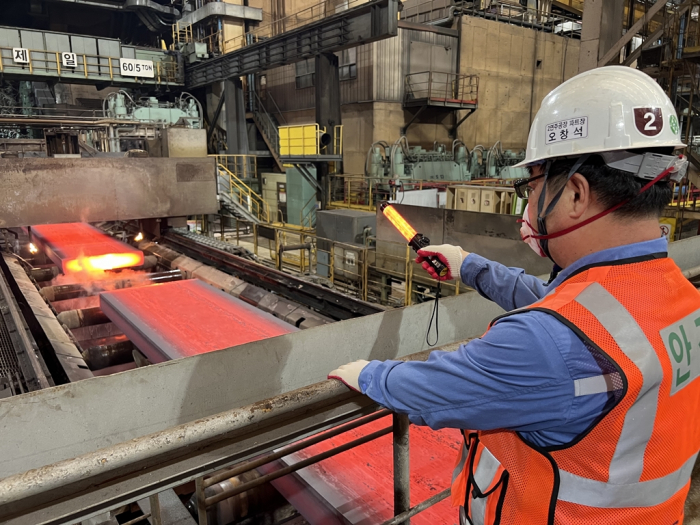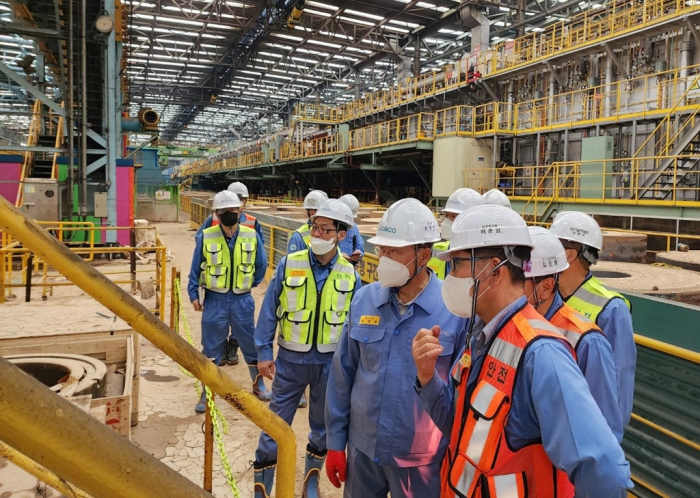Steel
POSCO may need months to normalize typhoon-hit steel mill
The vice minister of industry says it will take up to six months to restore the hot rolled plant and also long to reinstate the others
By Sep 14, 2022 (Gmt+09:00)
2
Min read
Most Read
LG Chem to sell water filter business to Glenwood PE for $692 million


Kyobo Life poised to buy Japan’s SBI Group-owned savings bank


KT&G eyes overseas M&A after rejecting activist fund's offer


StockX in merger talks with Naver’s online reseller Kream


Mirae Asset to be named Korea Post’s core real estate fund operator



POSCO, the world’s sixth-largest steelmaker, is expected to need months to resume full operations of its typhoon-hit plant, which makes up a quarter of South Korea’s steel production, a senior government official and industry sources said, even as the company restarted all of the three blast furnaces there.
Some other facilities such as rolling equipment, which Typhoon Hinnamnor hit hard, remained halted as restoration works are slow, according to POSCO officials.
The country’s top steel producer said on Wednesday it resumed normal operations of the No. 3 furnace on Sept. 10 and the other two – the No. 2 and No. 4 furnaces – at Pohang Steel Works on Sept. 12, all of which had been shut down for the first time in 49 years as many parts of the steel mill, including power lines, were flooded due to the storm. The oldest No. 1 furnace at the plant, about 350 kilometers southeast of Seoul, was already mothballed in late 2021.
POSCO also restarted some other equipment such as lines that remove impurities from molten iron produced from furnaces and adjust its ingredients for customer needs at the plant in the port city of Pohang, North Gyeongsang Province.
Many ground units stayed idle, however, including rolling facilities that process steel with heat and pressure as the entire plant was flooded with seawater due to the typhoon.
“We believe it will take up to six months to restore POSCO’s No. 2 hot rolled plant,” said Jang Young-jin, Vice Minister of Trade, Industry and Energy. “It is also expected to take a long time to reinstate other parts such as stainless facilities, although we need to check more on this.”
ONLY STEEL SLABS
The rolling facilities manufacture products such as hot rolled steel and cold rolled steel. Without them, POSCO is only able to produce steel slabs.
Reflecting investor concerns over those idled facilities, shares in POSCO Holdings Inc., the steelmaker’s holding company, tumbled 3.43% to 239,500 won ($172.1) on Seoul’s main stock market, far underperforming a 1.56% loss in the wider Kospi.
POSCO said the restoration work for the rolling units has made progress with the drainage of the facilities completed by some 90% although it was premature to set up further repair plans.
“It is predicted to take some time to restart the rolling process, but we will have to remove mud from the underground facilities to check the exact damage,” a company official said, declining to comment on Jang’s estimate of six months.

POSCO plans to send slabs for further processing to its own domestic steel mill in Gwangyang, which was not affected by the typhoon, and other companies in order to minimize the supply disruption of rolled steel products.
The measure will be insufficient, however, as the Pohang plant produced 16.9 million tons of crude steel last year, 44% of the company’s entire output and 24% of the country’s total production.
The steel mill manufactures 2.2 million tons of hot rolled steel, 2.9 million tons of cold steel, 3.4 million tons of plate and 2.7 million tons of wire rods annually.
Write to Kyung-Min Kang, Ik-Hwan Kim and Ji-Hoon Lee at kkm1026@hankyung.com
Jongwoo Cheon edited this article.
More to Read
-
 SteelPOSCO partially restarts Pohang furnaces flooded by typhoon
SteelPOSCO partially restarts Pohang furnaces flooded by typhoonSep 12, 2022 (Gmt+09:00)
2 Min read -
 SteelTyphoon Hinnamnor shuts all POSCO furnaces for 1st time in 49 years
SteelTyphoon Hinnamnor shuts all POSCO furnaces for 1st time in 49 yearsSep 07, 2022 (Gmt+09:00)
1 Min read -
 EconomyShipyards, TV plants to shut down as typhoon lands on Korea
EconomyShipyards, TV plants to shut down as typhoon lands on KoreaSep 05, 2022 (Gmt+09:00)
2 Min read -
 Carbon neutralityPOSCO mothballs Korea’s oldest blast furnace for carbon neutrality
Carbon neutralityPOSCO mothballs Korea’s oldest blast furnace for carbon neutralityDec 29, 2021 (Gmt+09:00)
3 Min read
Comment 0
LOG IN


